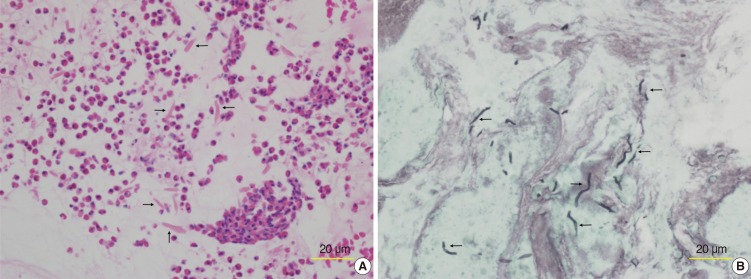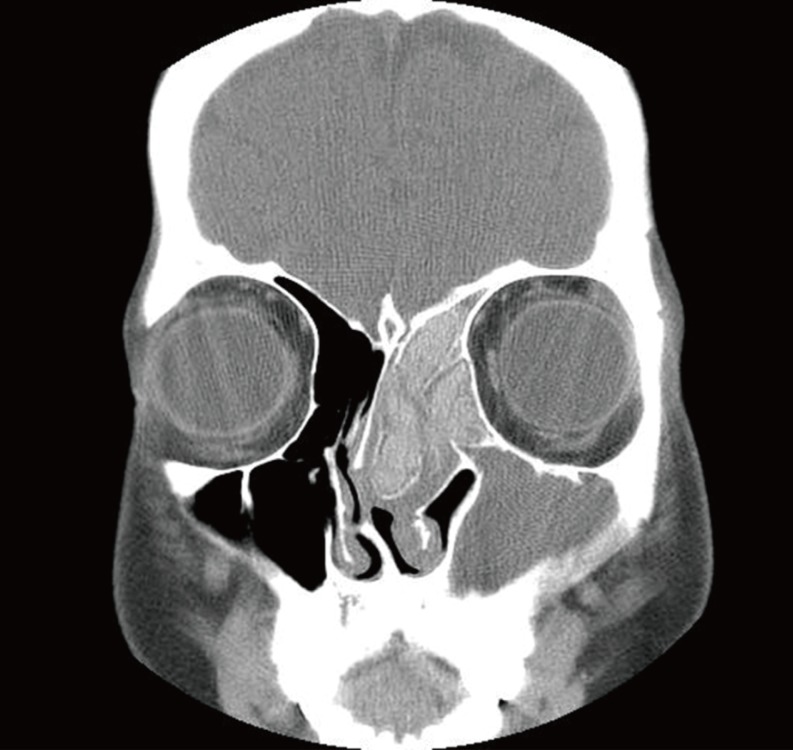Clin Exp Otorhinolaryngol.
2015 Mar;8(1):39-45. 10.3342/ceo.2015.8.1.39.
Categorization and Clinicopathological Features of Chronic Rhinosinusitis With Eosinophilic Mucin in a Korean Population
- Affiliations
-
- 1Department of Otorhinolaryngology-Head and Neck Surgery, Chungnam National University School of Medicine, Daejeon, Korea. ksrha@cnu.ac.kr
- KMID: 1973486
- DOI: http://doi.org/10.3342/ceo.2015.8.1.39
Abstract
OBJECTIVES
Chronic rhinosinusitis (CRS) with eosinophilic mucin is relatively rare in Korea. We categorized CRS patients with characteristic eosinophilic mucin into several groups and compared the groups based on their clinicopathological features.
METHODS
In total, 52 CRS patients with eosinophilic mucin were enrolled. Based on the presence or absence of an allergy (A) to a fungus or fungal element (F) in the mucin, the patients were divided into four groups: allergic fungal rhinosinusitis (AFRS, A+F+), AFRS-like sinusitis (A+F-), eosinophilic fungal rhinosinusitis (EFRS, A-F+), and eosinophilic mucin rhinosinusitis (EMRS, A-F-). Clinical and immunological variables were compared between the groups.
RESULTS
There were 13 patients in the AFRS group, 13 in the EFRS group, and 26 in the EMRS group. No patient was assigned to the AFRS-like sinusitis group. The AFRS group showed a significantly higher association with allergic rhinitis than did the EFRS and EMRS groups. The mean total serum IgE level in the AFRS patients was significantly higher than in the EFRS and EMRS patients. While 7.7% of the patients with AFRS and EFRS were asthmatic, 65.4% of the patients with EMRS had bronchial asthma. In the AFRS and EFRS groups, 31% had bilateral disease, in contrast to 100% of EMRS patients with bilateral disease. The prevalence of high attenuation areas by computed tomography was significantly higher in the AFRS group than in the EMRS group, and the mean Hounsfield unit values of the areas of high attenuation in the AFRS patients were significantly greater than those in the EMRS patients.
CONCLUSION
AFRS is believed to be an allergic response to colonizing fungi in atopic individuals. In EFRS, local allergies to fungi may play a role in the pathogenesis of the disease. EMRS is thought to be unconnected with fungal allergies.
Keyword
MeSH Terms
Figure
Cited by 2 articles
-
Risk Model Establishment of Endoscopic Sinus Surgery for Patients with Chronic Rhinosinusitis: a Multicenter Study in Korea
Jin-Young Min, Yong Min Kim, Dae Woo Kim, Jeong-Whun Kim, Jin Kook Kim, Ji-Hun Mo, Jae-Min Shin, Kyu-Sup Cho, Sanggyu Kwak, Seung-Heon Shin
J Korean Med Sci. 2021;36(40):e264. doi: 10.3346/jkms.2021.36.e264.Clinical and Radiological Characteristics of Central Compartment Atopic Disease in Korea
Hwaejoon Jung, Su-Jong Kim, Jee Won Moon, Jae Hoon Cho, Yong-Dae Kim, Heung-Man Lee
Korean J Otorhinolaryngol-Head Neck Surg. 2023;66(11):735-742. doi: 10.3342/kjorl-hns.2023.00766.
Reference
-
1. Sok JC, Ferguson BJ. Differential diagnosis of eosinophilic chronic rhinosinusitis. Curr Allergy Asthma Rep. 2006; 5. 6(3):203–214. PMID: 16579870.
Article2. Borish L, Rosenwasser L, Steinke JW. Fungi in chronic hyperplastic eosinophilic sinusitis: reasonable doubt. Clin Rev Allergy Immunol. 2006; 6. 30(3):195–204. PMID: 16785590.
Article3. Millar JW, Johnston A, Lamb D. Allergic aspergillosis of the maxillary sinuses [abstract]. Thorax. 1981; 36:710.4. Katzenstein AL, Sale SR, Greenberger PA. Allergic Aspergillus sinusitis: a newly recognized form of sinusitis. J Allergy Clin Immunol. 1983; 7. 72(1):89–93. PMID: 6853933.5. Robson JM, Hogan PG, Benn RA, Gatenby PA. Allergic fungal sinusitis presenting as a paranasal sinus tumour. Aust N Z J Med. 1989; 8. 19(4):351–353. PMID: 2783086.
Article6. Marple BF. Allergic fungal rhinosinusitis: current theories and management strategies. Laryngoscope. 2001; 6. 111(6):1006–1019. PMID: 11404613.
Article7. Chakrabarti A, Denning DW, Ferguson BJ, Ponikau J, Buzina W, Kita H, et al. Fungal rhinosinusitis: a categorization and definitional schema addressing current controversies. Laryngoscope. 2009; 9. 119(9):1809–1818. PMID: 19544383.8. Bent JP 3rd, Kuhn FA. Diagnosis of allergic fungal sinusitis. Otolaryngol Head Neck Surg. 1994; 11. 111(5):580–588. PMID: 7970796.
Article9. Allphin AL, Strauss M, Abdul-Karim FW. Allergic fungal sinusitis: problems in diagnosis and treatment. Laryngoscope. 1991; 8. 101(8):815–820. PMID: 1865728.10. Ramadan HH, Quraishi HA. Allergic mucin sinusitis without fungus. Am J Rhinol. 1997; Mar-Apr. 11(2):145–147. PMID: 9129757.
Article11. Ferguson BJ. Eosinophilic mucin rhinosinusitis: a distinct clinicopathological entity. Laryngoscope. 2000; 5. 110(5 Pt 1):799–813. PMID: 10807359.
Article12. Collins M, Nair S, Smith W, Kette F, Gillis D, Wormald PJ. Role of local immunoglobulin E production in the pathophysiology of noninvasive fungal sinusitis. Laryngoscope. 2004; 7. 114(7):1242–1246. PMID: 15235354.
Article13. Carney AS, Tan LW, Adams D, Varelias A, Ooi EH, Wormald PJ. Th2 immunological inflammation in allergic fungal sinusitis, nonallergic eosinophilic fungal sinusitis, and chronic rhinosinusitis. Am J Rhinol. 2006; Mar-Apr. 20(2):145–149. PMID: 16686376.
Article14. Ponikau JU, Sherris DA, Kern EB, Homburger HA, Frigas E, Gaffey TA, et al. The diagnosis and incidence of allergic fungal sinusitis. Mayo Clin Proc. 1999; 9. 74(9):877–884. PMID: 10488788.
Article15. Hamilos DL. Allergic fungal rhinitis and rhinosinusitis. Proc Am Thorac Soc. 2010; 5. 7(3):245–252. PMID: 20463255.
Article16. Hutcheson PS, Schubert MS, Slavin RG. Distinctions between allergic fungal rhinosinusitis and chronic rhinosinusitis. Am J Rhinol Allergy. 2010; Nov-Dec. 24(6):405–408. PMID: 21144218.
Article17. Kim JW, Hong SL, Kim YK, Lee CH, Min YG, Rhee CS. Histological and immunological features of non-eosinophilic nasal polyps. Otolaryngol Head Neck Surg. 2007; 12. 137(6):925–930. PMID: 18036422.
Article18. Zhang N, Van Zele T, Perez-Novo C, Van Bruaene N, Holtappels G, DeRuyck N, et al. Different types of T-effector cells orchestrate mucosal inflammation in chronic sinus disease. J Allergy Clin Immunol. 2008; 11. 122(5):961–968. PMID: 18804271.
Article19. Ishitoya J, Sakuma Y, Tsukuda M. Eosinophilic chronic rhinosinusitis in Japan. Allergol Int. 2010; 9. 59(3):239–245. PMID: 20657162.
Article20. Schubert MS. Fungal rhinosinusitis: diagnosis and therapy. Curr Allergy Asthma Rep. 2001; 5. 1(3):268–276. PMID: 11892045.
Article21. Schubert MS, Goetz DW. Evaluation and treatment of allergic fungal sinusitis. I. Demographics and diagnosis. J Allergy Clin Immunol. 1998; 9. 102(3):387–394. PMID: 9768578.
Article22. Mabry RL, Marple BF, Folker RJ, Mabry CS. Immunotherapy for allergic fungal sinusitis: three years' experience. Otolaryngol Head Neck Surg. 1998; 12. 119(6):648–651. PMID: 9852541.
Article23. Mukherji SK, Figueroa RE, Ginsberg LE, Zeifer BA, Marple BF, Alley JG, et al. Allergic fungal sinusitis: CT findings. Radiology. 1998; 5. 207(2):417–422. PMID: 9577490.
Article24. Lara JF, Gomez JD. Allergic mucin with and without fungus: a comparative clinicopathologic analysis. Arch Pathol Lab Med. 2001; 11. 125(11):1442–1447. PMID: 11697999.25. Bozeman S, de Shazo R, Stringer S, Wright L. Complications of allergic fungal sinusitis. Am J Med. 2011; 4. 124(4):359–368. PMID: 21435427.
Article26. Manning SC, Holman M. Further evidence for allergic pathophysiology in allergic fungal sinusitis. Laryngoscope. 1998; 10. 108(10):1485–1496. PMID: 9778288.
Article
- Full Text Links
- Actions
-
Cited
- CITED
-
- Close
- Share
- Similar articles
-
- Clinical Characteristics and Treatment of Fungal Rhinosinusitis
- Medical treatment according to phenotypes of chronic rhinosinusitis
- Eosinophilic Chronic Rhinosinusitis
- Clinicopathological Characteristics of Eosinophilic Fungal Rhinosinusitis
- Clinical Characteristics and Expression Pattern of IL-33 and IL-25 According to Histologic Classification in Chronic Rhinosinusitis with Nasal Polyposis




